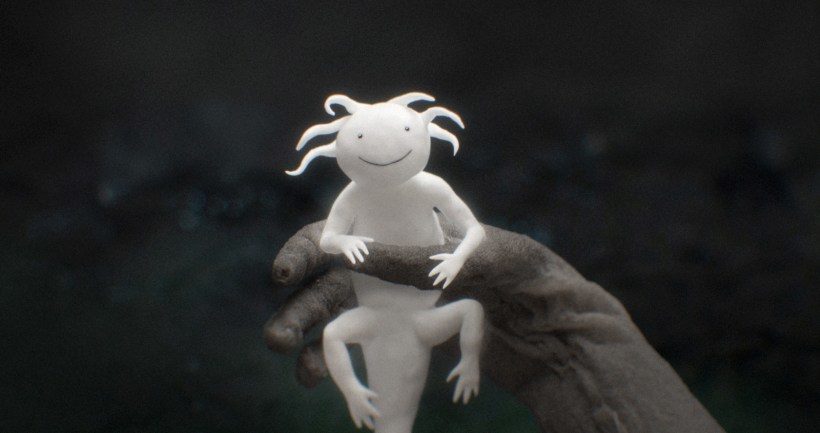
ZOON © Jonatan Schwenk
Enraptured, the two-legged creature picks the blissfully smiling axolotl up from the earth and pops it in its mouth. Sheer joy. Doing so, its hands – filigree stick-puppet hands – initially reach out tentatively then greedily for the tasty stop-motion being. In Jonatan Schwenk’s ZOON, over and again we encounter so many nuances and animation techniques, all at the same time. Which means that Schwenk must be completely immersed in the medium of animation, right? “The animation technique as such is not that important for me, actually,” the 34-year-old independent filmmaker and animator then announces surprisingly in conversation. “It only represents the route needed to tell what I want to tell.” Animation as a practical, haptic tool – and as a means to an end. This view is quite in contrast to the romanticising receptions of animation that almost reverently superelevate the medium as a passionate yet dreamy state of immersion. On the other hand, it is also in contrast to the technical focus that many practitioners have, also within the animation sector. Perhaps it is this approach that makes Jonatan Schwenk’s hybrid and apparently haptic films seem so striking to us. And this has already bestowed a number of successes on him: His work SOG (3D digital, puppets, live action and 2D digital) from 2017 was awarded more than 40 times internationally with prizes and special mentions, including the Cristal for Best Student Film at Annecy. His current film ZOON is on the international festival circuit right now, having had its world premiere at the Sundance Film Festival in January. This was followed in June 2022 by the Animafest Zagreb and the Kurzfilm Festival Hamburg. Likewise, ZOON has been selected for the NEXT GENERATION SHORT TIGER, the talent showcase from German Films that presents a selection of student films each year in Cannes and then globally.
Hybrid Narratives of Being Human
For Jonatan Schwenk, the individual scenes narrated are microcosmic and creature-centric, perhaps because of their frequently handcrafted details. Yet in terms of the content, he focuses on the human condition in its entirety. Schwenk is on a par here with Robert McKee, the luminary of filmic storytelling in that he wants to “tell a story that is universally valid as far as possible, but come up with as many fresh images as possible – images that we do not yet know as such.” And which can ultimately provide identification for the greatest number of viewers. In any case, SOG is concerned with no less that Darwin and Hobbes. After a flood, fish are left hanging in the trees and start roaring. Their permanent screaming initially drives the other cave creatures living there to despair, and then livid. With grievous consequences. Schwenk even spells out this encounter with otherness formally by using two different animation techniques – the stop-motion fish puppets and the 3D creatures that clash with each another.
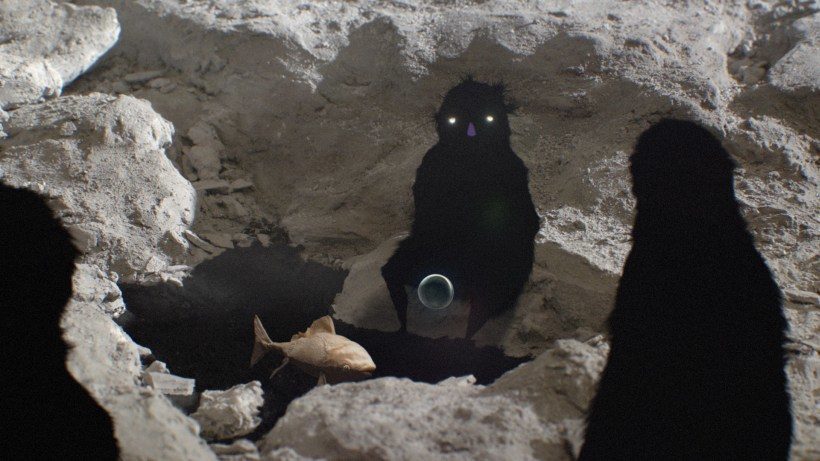
SOG © Jonatan Schwenk
SOG may be viewed as a timeless parable, but timewise, it also fits well into the societal discussions about refugees fleeing to Germany from 2015 onwards. Nonetheless, Jonatan Schwenk does prefer to work and focus more intensively on aspects of timelessness, parables and the human condition as such, rather than on some concrete political moment. This becomes all the more transparent with ZOON (Latin: living creature), where two species again encounter each other, with one of them putting the other one in its place, Darwinistically speaking. Just that here the axolotls are enjoying being devoured and the two-legged creatures in turn have become part of a larger deterministic (exploitation) chain.
Own Ideas as Inspiration rather than Role Models
While SOG already seems almost naturalistically oppressive with its barren treescapes and gloomy caves, ZOON, despite its potentially apocalyptic interpretation, feels more surrealist – and even a little tongue-in-cheek. This is due on the one hand to the consciously chosen, almost kitschy cloudscape in the sky where the film’s finale plays out, and on the other hand to the eyes and mouths (as well as the feet and hands) that Jonatan Schwenk digitally drew by hand on both of these sets of creatures.
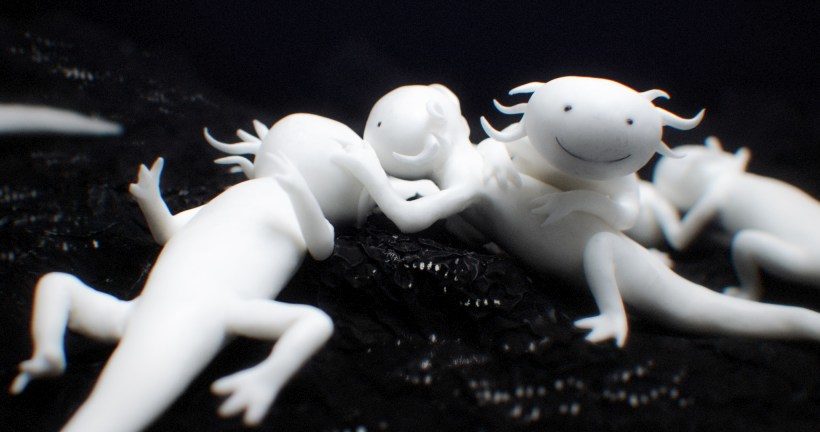
ZOON © Jonatan Schwenk
A change in tone: “After SOG, I needed something more positive, something not so completely dystopian,” Schwenk says, and when asked about the colour of the sky, he adds: “I like the concept of magic realism.” The Studio Ghibli productions provide apt inspirations for this: The real world frequently slips into the magical world there, without immediately becoming science fiction in the process. But there is no fixed canon that Schwenk grapples with, or role-model images that he deliberately emulates. Quite the opposite: Nowadays, he often prefers to read at night rather than check out the next blizzard of images from the internet – on the one hand to put a stop to the sensory overload, and on the other hand to accord greater space to his own world of ideas. But for that, his all-time favourite work is truly part of the literary canon: “Lord of the Flies” from William Golding. This classic novel gleams with quite a pessimistic view of humankind, one that has also accompanied Jonatan Schwenk at times, although he does also always like to offer constructive, positive ways out with his films.
From the Changing Room to the Animation Studio
The avoidance of being completely drowned in a flood of images – this way of navigating everyday life may have its roots in Schwenk’s childhood. Schwenk grew up without television and first dabbled in animation as a teenager: In a converted sports changing room at his school in Göttingen, he shot and animated his first stop-motion film, an entertaining eight-minute piece, together with a bunch of friends. Aardman was the main inspiration for their work and laughter the intended audience reaction. It was only during his studies that Schwenk discovered for himself how well animation also worked with the more serious material that he actually wanted to tell.
The first films followed during his study time – using human characters that he then bid farewell to later on with SOG and ZOON. Such as SISYPHOS BLUES from 2009, from instance, which was made in his first semester at Offenbach using a combination of claymation and drawing. Here, Schwenk spells out the everyday life of being stuck in a hamster wheel consisting of work and amusing diversions, including an actual Sisyphus stone. Yet already in MAISON SONORE from 2011, Schwenk’s love for the not-quite-resolvable metaphor becomes apparent, touching upon his fondness for magic realism. MAISON SONORE, which was screened at more than 20 international festivals, including Annecy, explores and illuminates living together, or perhaps better said, the existing next to each other of various parties and floors in a residential building. Somewhere, a mechanic taps on the waterpipe; elsewhere, people are standing in an endless queue for a public authority office. Their only commonality is that all of them appear to be quite unhappy, well experienced in misfortune. And only the accordionist playing in an abandoned flat seems to bring about any change. But why an accordion especially? “For me, this instrument innately sounds a bit like wanderlust, like nostalgic memories, and a bit like as though it’s actually dreaming of being a complete orchestra. Which worked well in MAISON SONORE, because I wanted to convey the sense of being bogged down in existing structures,” Schwenk explains. This film was also created as a claymation. Schwenk already worked with more detailed models of rooms for this film, which would subsequently transition into ever more filigree ones, preferably situated in outdoor settings. And also the accordion – Nils Wildegans scored both films – then gave way to music that is not used primarily for dramatic or rhythmic effect, and instead subtly provides a soundscore to the dark sides of human nature.
Although Schwenk has long been a regular guest at festivals: Even his two best-known films are student works. For his first degree in a minor subject, he started working on SOG during his visual communication studies at the HfG Offenbach Hessen State University of Art and Design and finished the film as a guest student at the Kunsthochschule Kassel School of Art. ZOON is his graduation film. Several professors left their mark on him at university, including Rotraut Pape, for instance – especially because she simply let him do what he wanted to do. It is also thanks to her that he regards artistic freedom as far more important during animation studies than tight study schedules and sticking strictly to the principles of animation. And as part of what constitutes good schooling for the wild outdoors after graduating from the safe haven of university.
Working Processes: Alone and in Teams
Thinking out the animation from the storyline: Schwenk’s work philosophy also flows into the practical animation processes, step by step. As soon as he has the screenplay (the be-all and end-all!) and then the animatic ready, he likes to try out everything by himself first before he seeks out expert support. For instance, during the pandemic lockdown Schwenk animated the clay axolotls from ZOON completely alone frame-by-frame in TORP Studio in Berlin-Kreuzberg, the animation network where he works together with Dina Velikovskaya (TIES), among others.
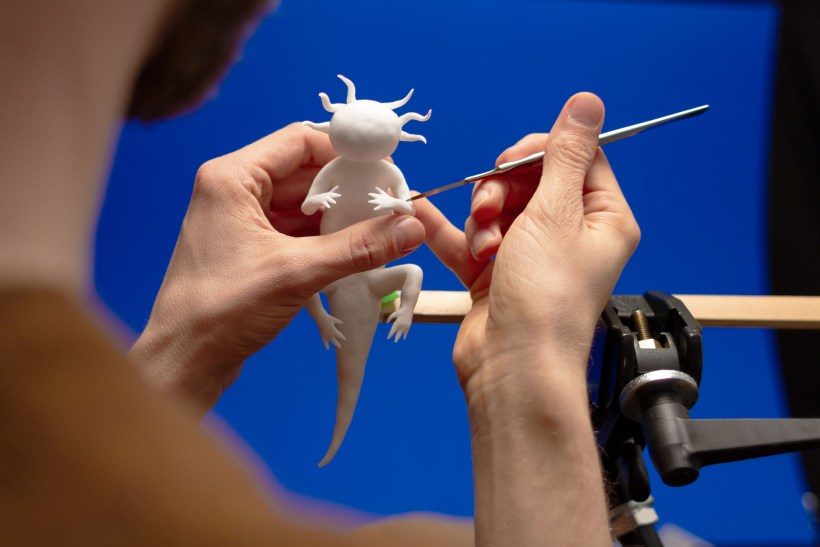
stop-motion work on ZOON © Jonatan Schwenk
By contrast, the two-legged creatures are stick puppets, each of which were moved and tracked by two to three people in real time in front of a blue screen. Through this use of live action, he wanted to leave “more space for chance” that he misses at times in the precisely timed animation medium. Moreover, in all the working processes, Schwenk likes to work together with friends and colleagues, such as Merlin Flügel (RULES OF PLAY among others), for instance, who provided decisive help on both films developing the idea and supplying important input, or Marta Magnuska too. On the other hand, Jonatan Schwenk is also more than happy to support his colleagues from his network, including being their sound designer (e.g., on Florian Maubach’s COPS & ROBBERS that won the 2018 German Short Film Award, or also on Merlin Flügel’s RULES OF PLAY, winner of the 2019 Cristal for Best Graduate Film in Annecy).
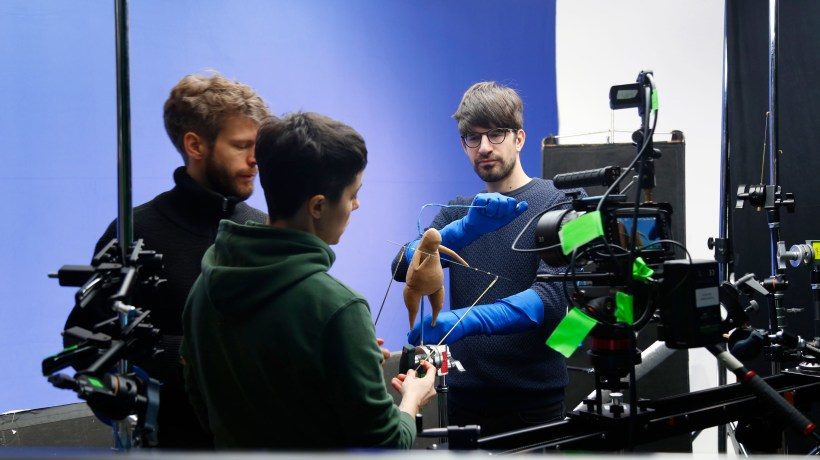
team work – animation of the stick puppets in ZOON © Jonatan Schwenk
Structural and Personal Challenges – And New Projects
Schwenk spent four years crafting SOG and two and a half years on ZOON, production times that Schwenk also attributes to the lack of funding structures – he was obliged to work at the same time on other projects to survive and make ends meet. The German system has a lot of catching up to do when it comes to basic income, funding and residency opportunities, Schwenk feels, especially when we take a look at France. Perhaps Jonatan Schwenk was still quite impressed by his recent experiences in France when the conversation with him was recorded for this portrait: It was only in April 2022 that, thanks to the “NEF International Residency for Animated Film”, he was able to spend several weeks in the Abbey of Fontevraud, a residency in an idyllic setting intended for animated filmmakers, among others. Moreover, in 2020 he was one of the 250 selected Talents of Berlinale Talents, the Berlinale’s initiative for up-and-coming filmmakers. Likewise, above and beyond his own films, promoting and fostering talent constitutes an important ambition for Schwenk. In addition to gaining new members in the field of animation, he has been responsible for fostering talent with AG Animationsfilm, the Animation Association Germany, on whose board he has been a member since the end of 2021.
Yet even with improved production conditions, both his intellectual and physical occupation with his work will always remain very time-consuming. Which does not make it easy to achieve a good work-life balance. And balancing out the two extremes between being “behind the curtain and then suddenly on stage” – or even between the filmmaking and the screening of a film or the whirlwind of communications at a festival – is also not without complications. But despite receiving exactly those kinds of festival invitations from all over the world, he is already full of ideas and enthusiasm for his next project, about which he prefers not to reveal too much (except that it will perhaps have human characters – real humans; and it may even include some dialogue). It will be his debut, venturing beyond the university cosmos. Merlin Flügel likes the screenplay, he says, which makes for a good start. Any chance that this film will be another parable about the underbelly of human nature? Jonatan Schwenk nods vehemently, “Of this I’m a hundred percent certain.”